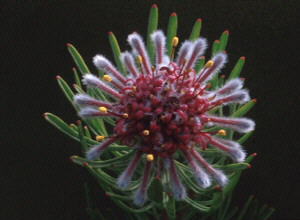
Home
Mission
Overview of Project
Project Staff
Sponsors
Achievements
Checking, Illustrations
Upcoming Activities
Id and Species Lists
Protea Information
Protea Gallery
Growing Proteas
Interim Dist. Maps
Publications
Afrikaanse Inligting
![]()
Are Vexators Aptly Named?
Dr John Rourke created the genus Vexatorella to help solve a little taxonomical problem. Just perhaps, he had an additional reason for naming the troubling genus, which has not yet been revealed! Read on …
Tony Rebelo and I set off for the Pat Busch Nature Reserve one Sunday morning. We duly got permission to climb Middelrug, which is a smallish and innocuous-looking ridge near Robertson, forming a gentle buttress to prop up the Langeberg. We were on the lookout for the Robertson Vexator – Vexatorella latebrosa. The climb up the ridge was very pleasant as there was a path, and even more pleasant as Tony’s pace was reasonable due to a sprained ankle from the previous day’s antics. Unfortunately, the top of the Middelrug ridge was burnt and so too we feared, was the elusive Ve latebrosa. It is not known from Middelrug ridge, but just in case it was there, we checked. We couldn’t find it and this was our first irritation of the day.
Six-month old veld makes for really pleasant walking, as we all know, and we were soon at the very top of the buttress at the foot of the Langeberg on the south, cool slopes. This is where our real fun began when we traversed west across the Langeberg to get onto the ridge from where the Vexator is known. There were two problems though:
- The six-month old veld comprised a dense stand of 2 metre high daisies in amongst a dense stand of Common Shuttlecock Sugarbush - Protea aurea aurea skeletons; and,
- There was a nasty little deep and narrow ravine that had to be crossed.
We successfully negotiated both hurdles, but poor Tony’s ankle was really beginning to moan.
 Great … we are now on
the right ridge heading south and hot on the trail of the Vexatorella. Instead of
dense Pr aurea aurea skeletons we had a dense stand of Narrow-leaf Sugarbush - Protea neriifolia
skeletons to walk through. You all know what it is like walking through dead skeletons!
Those branches and twigs don’t move but rather tend to make little to big holes in
legs and arms or at best, scratch you. Still no Vexatorella! As we moved away from
the shadow of the Langeberg, so the vegetation eased up and our very, very serious search
for the plant was on. I was clutching at straws and convinced that every small plant was
the Vexatorella. Eventually, we found clumped 15cm-high Ve latebrosa
with the characteristic channelled leaf. Tony atlassed the east side of the ridge where
most of the plants grew. I atlassed the west and drier side of the ridge and found a few
plants as well. And so, another tick! But all was not yet over.
Great … we are now on
the right ridge heading south and hot on the trail of the Vexatorella. Instead of
dense Pr aurea aurea skeletons we had a dense stand of Narrow-leaf Sugarbush - Protea neriifolia
skeletons to walk through. You all know what it is like walking through dead skeletons!
Those branches and twigs don’t move but rather tend to make little to big holes in
legs and arms or at best, scratch you. Still no Vexatorella! As we moved away from
the shadow of the Langeberg, so the vegetation eased up and our very, very serious search
for the plant was on. I was clutching at straws and convinced that every small plant was
the Vexatorella. Eventually, we found clumped 15cm-high Ve latebrosa
with the characteristic channelled leaf. Tony atlassed the east side of the ridge where
most of the plants grew. I atlassed the west and drier side of the ridge and found a few
plants as well. And so, another tick! But all was not yet over.
We now had to get off the mountain. A steep descent into a beautiful wooded ravine, mainly on our behinds, was followed by a horrendous hack through brambles and other thick riverine vegetation before we emerged into the heat of the day and the road back to the car.
I maintain that the Vexatorella genus is most aptly named, but don’t let this stop you from going and having a look at Vexatorella latebrosa. We didn’t choose the easiest way to get there – you need only do one short 50 m serious, riverine, bundu bash and then up 50 m on a steep slope!
Nigel Forshaw
Back PAN 49